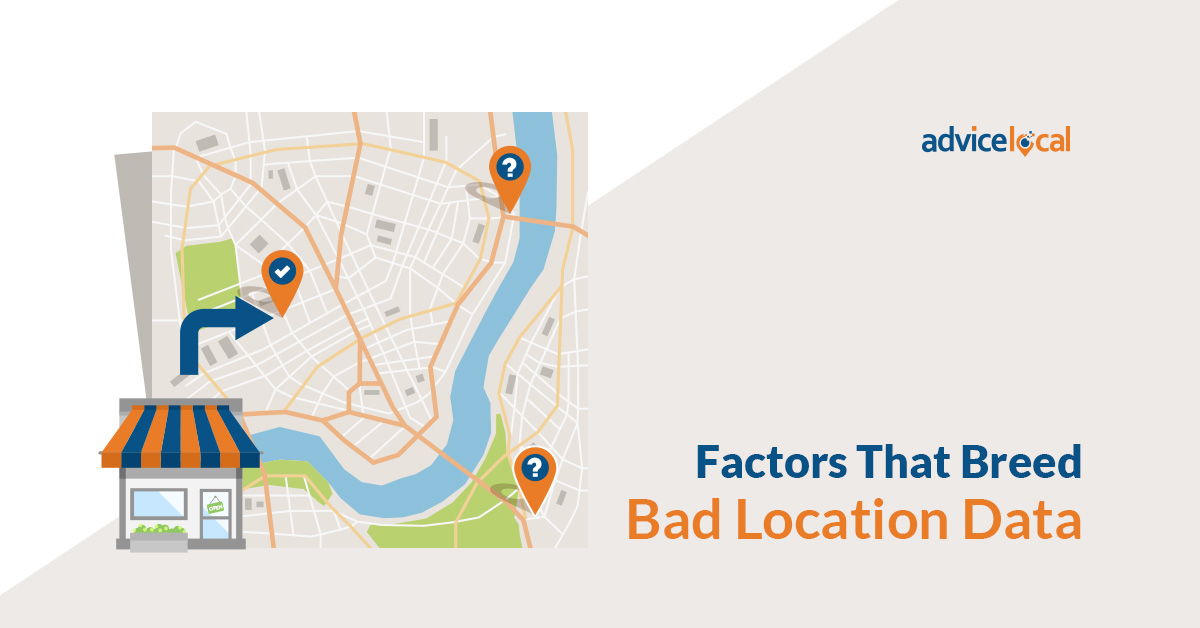Managing the local presence of a business all starts with understanding citations and why they are important. Once you understand that, you can move on to bad location data and how to correct it.
There is an endless stream of data available on the internet and while we love data, we cannot trust all of it. Today I’m going to focus in on NAP data (name, address, phone number), and examine how this data causes issues for a business when it becomes corrupt.
Studies have shown 67 percent of consumers lose trust in a brand if they get lost en route to a location due to an incorrect address online, and 73% lose trust in businesses that exhibit inconsistent location details.
If consumers can’t find the business, store or restaurant, how can they spend their money there? Furthermore, when they can’t find the business they move on to the next business that they can find. Plus, now they no longer trust the first business. This should be alarming to businesses and brands. And it’s all created by bad data.
So, how does bad data happen? Keep reading and find out!
How Bad Data Seeps onto the Internet
1. Businesses Create Their Own Bad Data
Yes, seriously, businesses create their own bad location data! While that is not intentional, whenever a business moves, rebrands or merges with another company it can create duplicate listings or incorrect citations. (Reminder, a citation is any mention of a business on the web, and it usually includes NAP data and sometimes a link to the business website.)
Maintaining consistent citations is an important part of doing business. You wouldn’t move without giving the post office your new address, would you? Keeping business citations accurate and updated is equally important, if not more so.
2. User-Generated Location Data
User-generated content – a popular and necessary evil – contributes items such as map listings that are created when a consumer checks in at a business, and social media pages created automatically when “Work and Education” fields are populated. This certainly doesn’t help the bad data problem. While creation of these items is outside a company’s control, it is imperative for the company to monitor, claim and remove them as needed.
3. Scrapping Data
Local presence management companies have a far reach and can update the majority of bad data on the internet. But there is an exception, and that is data on government websites. For the most part, this data consists of information that was taken from paperwork completed when a new business is founded or incorporated. It is then placed online, and most likely never again updated by the government entity.
This old data is indexed by search engines, and recognized as a citation about a particular business. Can you see the larger part of this dilemma? Other websites scrape the data from search engines and add it to the directories, making for even more bad data.
Search engines don’t have a way to tell for sure if the data is accurate or not. If there are many inconsistencies the data would most likely be buried in search results, so a consumer wouldn’t find it easily. However, the data that was scraped will still be available on the directory site – unless the business or brand corrects the listing or hires a local presence management company like Advice Local to correct it.
4. Duplicate Business Listings for the Same Location
How many times have you searched for a local business and 3 or 4 listings appeared, each saying something different? How could you tell which name, address and phone number was correct? Without doing some serious research you couldn’t.
These are called duplicate listings, and they are another big problem for local businesses and brands. These listings can appear due to several factors, such as variants of a business name, address and phone number.
These listings are created through the methods I discuss above, such as scraping, user-generated location data, and in combination with someone working outside the business who creates a new listing vs. claiming or optimizing an existing one. The ways through which these duplicates can and do occur is endless. One of the more common examples is when an employee of a business creates a listing under their own email account, and then later leaves the company. Down the line the company realizes the listing is now out of date, but instead of taking the necessary steps to gain access to the existing listing, they just create a new one. Problem solved, right? Unfortunately no – they now have a duplicate listing.
Now imagine for a moment how the above problems become amplified for businesses or brands with multiple locations. They might have 20 locations, and at least half of them have duplicate citations or incorrect data. Here’s an article that talks specifically to multi-location brands and their local presence management issues and solutions.
What is the Solution to Correct this Bad Data?
It would be great if I could tell you to take one or two steps and all the above problems would be eliminated, but I can’t because it just doesn’t work that way. It’s a process.
Here are three methods to get you started:
- Run a free online visibility report.
- Complete a citation audit. Here’s a free guide that walks you through the process.
- Hire a local presence management company. (Personally, I recommend this option. My team is standing by!)
Be sure to come back next week for more local search news from the #QueenofLocalSEO!




